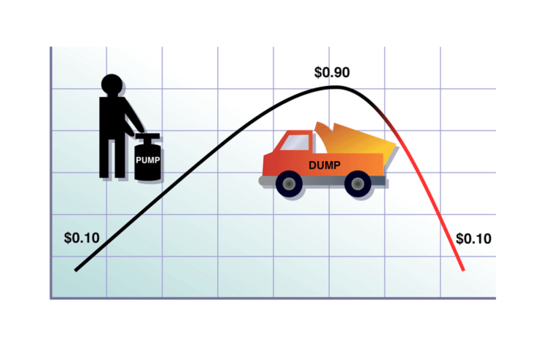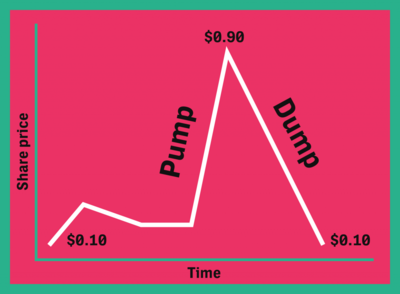Pump and Dump

Pump and Dump (P&D) is a common scheme used in cryptocurrency trading that involves inflating the price of an owned cryptocurrency through misleading statements, in order to sell the cheaply purchased cryptocurrency at a higher price.
Contents
What is pump and dump?
Many Pump and Dump schemes are organized via groups of the popular messaging app Telegram. The organizers try to get as many as possible people into the groups where they pretend to share insider information on the evolution of the cryptocurrency project and prices. Usually they pick a rather small coin, with lower market capitalization so the impact of a couple of hundred buyers will be significant on the price. Then they start sharing positive information that in most cases has no fundamentals behind. Usually they state a very concrete point in time where participants of the group should start to buy the coin.[1] People start buying the cryptocurrency and as the price increases more and more people start believing the organizers. In general there are various stages of price inflation. Towards the end of the action the organizers would sell the coin with massive gains. Soon after the price would fall again and return to the initial value or even below since previous regular investors lose trust in the project.
How does pump and dump work?
In a pump and dump scheme, the price of a worthless asset-usually a penny stock with a low market cap-is artificially inflated through well-planned marketing. False statements, misleading statements, a large number of social media posts, co-signs, and other chicanery are used to get the word out that a worthless asset is actually a hot buy that investors do not want to miss out on (the pump). To support these claims, the price of the worthless asset is increasing rapidly due to the well-planned pump. Once investors get word about the worthless asset and see its price rising rapidly, more investors start to buy up shares of the stock[2].
This is when individuals who are in on the pump and dump scheme will sell or “dump” the shares of the overvalued asset. These individuals profit from selling the asset at or near its peak for many times more than the price they purchased it at. When they begin to sell their shares of the overvalued asset, the price of the asset tanks and corrects to a more accurate and appropriate valuation.
P&D Stages
Pump Stage
Once the coin is decided, organizers buy their load. It gives them a head start to receive the highest benefit from the spike. However, organizers need to be careful that they do not pre-pump the coin. If the coin is the pre-pumped, i.e., purchase of coins by organizers before the actual pump, they will lose their group fans, and none would take part. Organizers need to be very careful to not pre-pump, i.e., if the coin volume on the exchange is low, the pump will spike the price. Once the group administrators have purchased, the information of the coin is passed to paid members and then to the outer participants of the scheme. If the pump is noticed by other traders on the exchange which are not part of the group, they too will purchase it.
Dump Stage
Organizers who bought coins in advance now sell or dump their coins on the outer circle which is still buying due to the pump. The quick sale brings the coin back to its initial value or lower resulting in heavy losses for those who purchased the token at the later stage of the pump. However, at times it is noticed that pumps lift the price of the coin permanently or at least for a few days.
Another type of P&D scheme is the celebrity pump; most notable is the John Mcafee pump. The benefit is that celebrities have many followers, which leads them to influence the newcomers to the crypto market easily. Organizers select a coin, the celebrity is paid his or her fees to pump the given coin. The Pump & Dump coins is a very risky scheme especially when you are not part of the inner circle. Although, overall this type of practice can harm the crypto space image on a longer run. If an influential person is asked by an anonymous person to dump on third-party coins, it could create an unstable market space.
The lack of regulation in the cryptocurrency market gives rise to such practices. Hence, it is best to research coins that will last over the long term and their purpose before investing in them. By trading and investing in higher volume cryptocurrencies, researching promising lower cap coins above a certain volume threshold, for instance 10,000, 5,000, etc., BTC per day, and by learning technical analysis, you have a better chance of avoiding being caught up in the shenanigans of P&D groups[3].
Consequences of pump and dump in crypto
During the execution of Pump and Dump schemes various smaller investors get ripped of their funds, since they usually are the ones suffering from losses while the organizers see big gains. For the cryptocurrency affected the scheme may cause a loss of trust by the community behind it and therefore may cause the project to suffer long term negative consequences.
Notable Pump and Dump events

In the following a list of events where Pump and Dump schemes were applied is presented:
ChainCoin July 2017 price hikes
Chaincoin is a cryptocurrency that saw almost no trading volume until June 2017. Among others the YouTube channel HighOnCoins started to promote the coin causing a price increase of more than 1000 times on July 14, 2017 followed by a very sharp decrease in price.
E-Coin January and February 2018 trading patterns
The trading pattern of the cryptocurrency E-coin suggests that in January and February 2018 the coin has repeatedly become a target of Pump and Dump schemes. [4]
McAfee coin of the day
The well known internet entrepreneur John McAfee used to publish his coin of the day on Twitter in late December 2017. The announcement led to increases in the price of the mentioned coin, bringing McAfee under substantial criticism he may conduct this practice for his own financial benefit. After he stopped announcing the coin of day on December 27 a series of tweets sent from his Twitter account promoted various coins. Later on it turned out that his Twitter account had been hacked.[5]
WhalePump Reborn Telegram Channel
Telegram groups and channels are often used for communicating price signals to followers. As Business Insider unveiled a Telegram group called WhalePump that later on turned into the Telegram Channel WhalePump Reborn periodically communicated buying signals for specific coins. In order to increase the impact organizers of Pump and Dump schemes usually focus on one particular exchange. Bittrex identified the irregular behavior that was going on at the exchange and tried to ban users engaging in these pump signals.[6]
References
- ↑ The Future: Inside the group chats where people pump and dump cryptocurrency, URL: https://theoutline.com/post/3074/inside-the-group-chats-where-people-pump-and-dump-cryptocurrency?zd=1&zi=nydrowz7
- ↑ CoinTelegraph – Pump&Dump – https://cointelegraph.com/news/pump-and-dump-in-crypto-cases-measures-warnings
- ↑ BTCManager – Breakdown cryptocurrency pump and dump – https://btcmanager.com/breakdown-cryptocurrency-pump-dump/
- ↑ Bitcoinchaser: Is E-coin The Biggest Pump And Dump Scheme Of 2018, URL: https://bitcoinchaser.com/news/e-coin-biggest-pump-and-dump-scheme-2018/
- ↑ BTC Manager: McAfee Claims Twitter Hack: “Coin of the Day” Rattles Altcoin Markets, URL: https://btcmanager.com/mcafee-claims-twitter-hack-coin-of-the-day-rattles-altcoin-markets/
- ↑ Business Insider, Meet the crypto trader who says he bought a Tesla with ‘pump and dump’ profits but claims the scams aren’t bad: ‘It’s a game’, URL: http://uk.businessinsider.com/interview-with-cryptocurrency-pump-and-dump-telegram-group-admin-2017-12